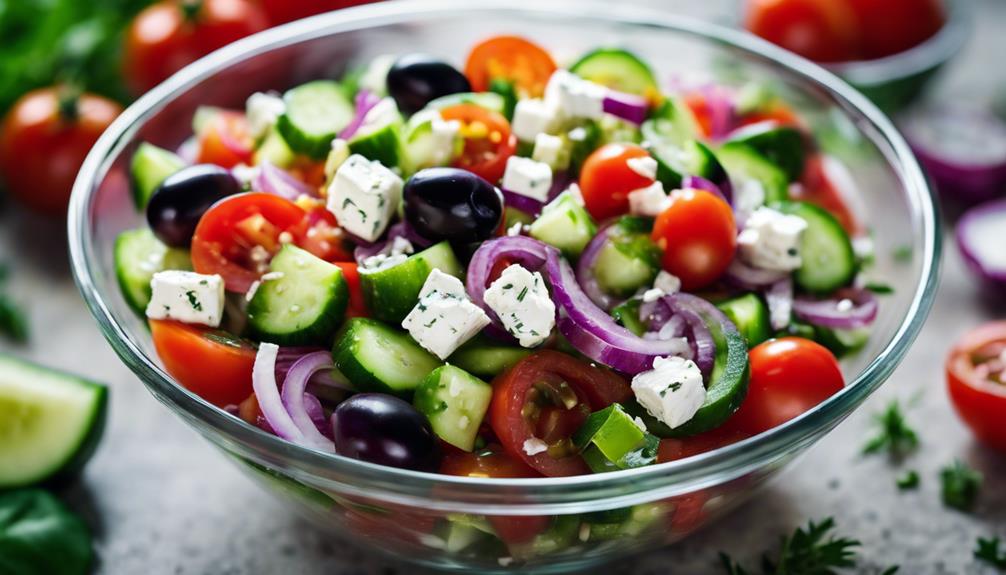Crafted with a vibrant mix of cucumbers, tomatoes, bell peppers, feta cheese, and Kalamata olives, a Chopped Greek Salad represents an energizing and nutritious side dish option. The Greek vinaigrette, made with olive oil, red wine vinegar, oregano, salt, and pepper, provides a tangy kick. When preparing, dice the vegetables evenly and soak onions briefly to soften their sharp flavor. Mix with the dressing right before serving to keep the dish fresh. Personalize with falafel or chickpeas for added protein or dietary preferences. Whether served with Mediterranean cuisine or enjoyed as a standalone meal, this salad supports heart-healthy choices and various dietary requirements.
Key Takeaways
- Loaded with fresh vegetables rich in essential nutrients
- Feta cheese and olives provide healthy fats and protein
- Low-calorie, high-fiber option for a nutritious side
- Aligns with Mediterranean diet for heart health benefits
- Easily customizable for various dietary preferences
Ingredients for Chopped Greek Salad
When preparing a Chopped Greek Salad, gather cucumbers, tomatoes, bell peppers, red onions, feta cheese, and Kalamata olives as the main ingredients. These components come together to create a vibrant and flavorful salad that's a staple in Greek cuisine.
The feta cheese adds a creamy and tangy element, while the red onions provide a key kick of flavor. Kalamata olives offer a briny and rich taste that complements the freshness of the cucumbers.
To tie everything together, the traditional Greek Salad dressing includes olive oil, red wine vinegar, oregano, salt, and pepper. This dressing enhances the natural flavors of the ingredients, giving the salad its signature taste.
Each component plays an important role in achieving the perfect balance of textures and flavors in this classic Greek dish. As you prepare your salad, make sure that each ingredient is finely chopped to allow for a harmonious blend of tastes in every bite.
Step-by-Step Salad Preparation
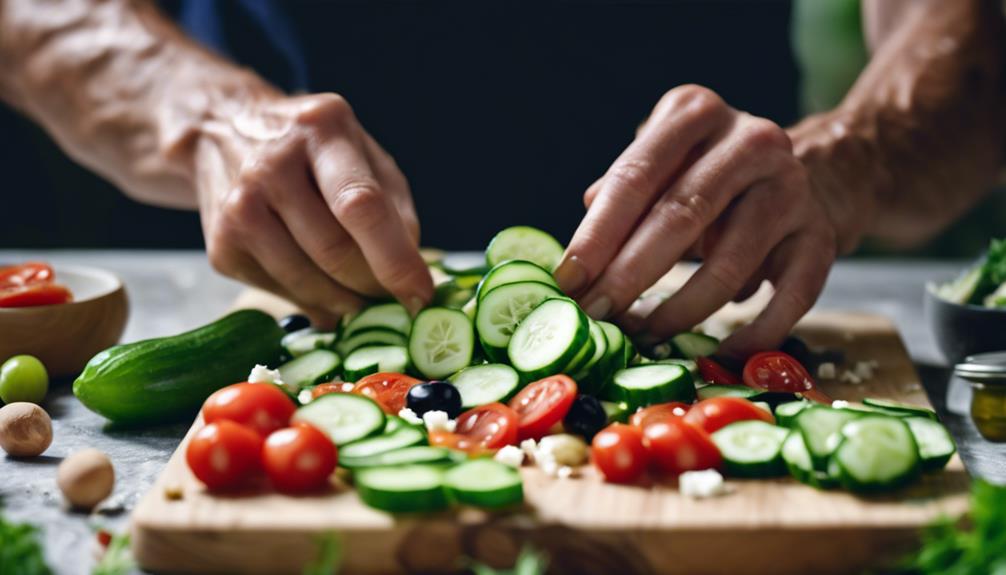
To begin preparing your Chopped Greek Salad, start by washing and dicing the cucumbers, tomatoes, bell peppers, red onions, feta cheese, and Kalamata olives.
Once all the vegetables are chopped to your liking, make the simple Greek vinaigrette dressing by whisking together olive oil, red wine vinegar, lemon juice, garlic, oregano, salt, and pepper.
In a large bowl, add the diced vegetables, feta cheese, and Kalamata olives. Pour the prepared dressing over the ingredients and toss to combine, ensuring an even coating of flavors.
This healthy salad not only tastes delicious but also offers extra protein from the feta cheese. The combination of fresh vegetables, tangy feta cheese, and briny Kalamata olives will make you love every bite of this vibrant and satisfying dish.
With its versatility, you can add ingredients like falafel or chickpeas for an extra protein boost or customize it to suit your taste preferences.
Tips for Perfect Chopped Salad
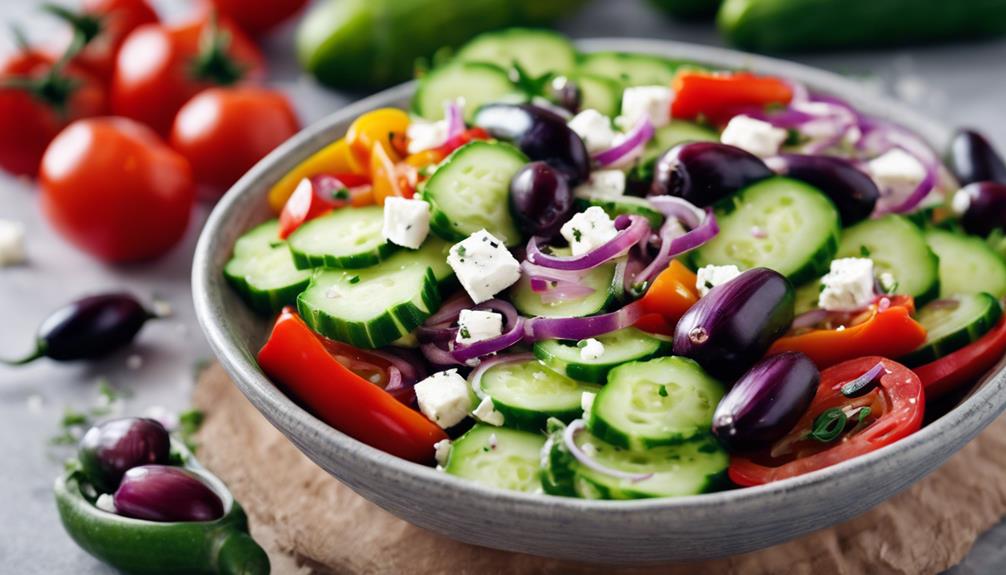
For consistent taste and texture in your chopped Greek salad, make sure you use high-quality ingredients and dice the vegetables uniformly. This attention to detail guarantees each bite contains a balanced mix of flavors and textures.
When chopping onions for your salad, consider soaking them in water for about 10 minutes to reduce their sharpness and enhance the overall flavor profile of the dish. Additionally, it's advisable to add the dressing just before serving to keep the salad fresh and maintain its crunchy texture.
To preserve any leftovers, store the chopped Greek salad in an airtight container in the refrigerator for up to 2 days. If you prefer a longer shelf life, consider adding the dressing on the day of consumption to prevent the salad from becoming soggy.
Whether you serve it as a main course or a side dish, this chopped Greek salad pairs well with various accompaniments such as legumes, grains, or proteins, making it a versatile and satisfying meal option.
Serving Suggestions and Pairings
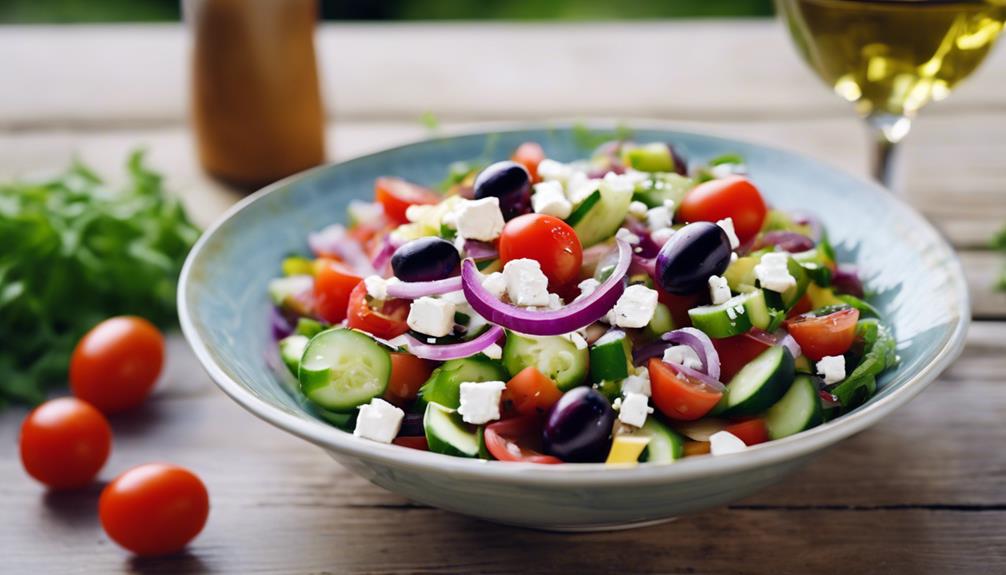
Enhance your chopped Greek salad experience by exploring various serving suggestions and perfect pairings that complement its vibrant flavors and textures.
This traditional Greek salad can be elevated by serving it alongside Mediterranean dishes such as veggie pizza, pita sandwiches, or lentil soup. Whether as an invigorating side salad or a main course with added protein like falafel or chickpeas, this versatile dish offers a delightful culinary experience.
For those looking into meal prep options, rest assured that this salad stores well for up to 4 days, making it a convenient choice for busy schedules. Customize your Greek salad by omitting feta for a dairy-free or vegan version.
To turn it into a complete meal, consider incorporating legumes, grains, or proteins like chicken, shrimp, or salmon. With these serving suggestions and pairings, you can enjoy the fresh and tangy flavors of a Greek salad in a way that suits your preferences and dietary needs.
Benefits of Greek Salad
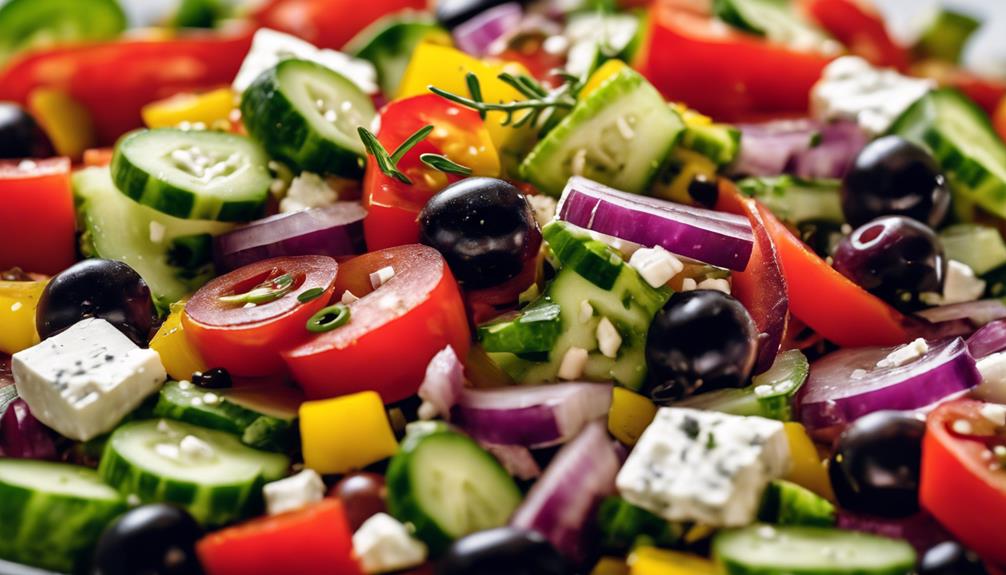
Have you ever wondered why Greek salad is considered a nutritional powerhouse?
Greek salad incorporates a variety of fresh vegetables like cucumbers, tomatoes, and bell peppers, delivering a substantial amount of essential vitamins and minerals important for overall health.
Additionally, the inclusion of olives and feta cheese in Greek salad provides healthy fats and protein, offering a satisfying and nutritious side dish.
Despite being low in calories, Greek salad is rich in fiber, making it an excellent choice for individuals aiming to uphold a healthy diet.
Moreover, the ingredients found in Greek salad, such as olive oil and oregano, align with the principles of the Mediterranean diet renowned for its heart-healthy advantages.
Frequently Asked Questions
Is Eating Greek Salad Healthy?
Eating Greek salad is healthy. Packed with fresh veggies, rich in vitamins, minerals, and antioxidants, it's low-calorie yet high-fiber. Feta cheese adds calcium and protein, while the olive oil dressing enhances flavor and health benefits.
Why Are Chopped Salads so Good?
You know why chopped salads hit the spot? They blend the best of flavors and textures in each forkful. They're easy to eat, visually enticing, and let you pack in more veggies deliciously. Try one today!
Why Is a Greek Salad so High in Calories?
A Greek salad is high in calories due to calorie-dense ingredients like feta cheese, olives, and olive oil dressing. These delicious components contribute to the richness of the dish, making it flavorful but also calorie-heavy.
What Are the Benefits of Mediterranean Salad?
Embrace the benefits of a Mediterranean salad with its rich antioxidants, fiber, and heart-healthy fats. Reduce chronic disease risks like diabetes and cancer. Enjoy vibrant flavors of colorful veggies, herbs, and olive oil for a nutritious meal.
Can Catie’s Greek Chickpea Salad be a side dish for a meal?
Catie’s refreshing Greek chickpea salad can definitely serve as a delicious side dish for any meal. The combination of fresh vegetables, tangy feta cheese, and savory chickpeas makes it a versatile and healthy option to accompany any main course. Plus, it’s packed with protein and flavor.
Conclusion
To sum up, the chopped Greek salad is an invigorating and healthy side dish that's simple to prepare and bursting with flavors. With a combination of fresh vegetables, olives, feta cheese, and a tangy dressing, this salad can be a perfect addition to any meal.
So why not try this Mediterranean-inspired dish today and treat your taste buds to a culinary journey through the sunny shores of Greece. After all, a taste of Greece is just a chop away!
